
table of contents
- Butterfly species in Germany
- Admiral (Vanessa atalanta)
- Aurora butterfly (Anthocaris cardamines)
- C-butterfly (Polygonia c-album)
- Great Cabbage White butterfly (Pieris brassicae)
- European common blue (Polyommatus icarus)
- Little fox (Vanessa urticae)
- Chess board (Melanargia galathea)
- Swallowtail (Papilio machao)
- Peacock butterfly (Vanessa io)
- Mourning cloak (Aglais antiopa)
- Brimstone Butterfly (Gonepteryx rhamni)
Who does not know them, the colorful messengers of summer. The butterflies (Lepidoptera) prance from flower to flower on the colorful summer meadow. They can be seen again on time with the first rays of sunshine in spring. Wherever there are flowering plants, there is sweet nectar for them. There are numerous species of butterflies that differ in color, shape and size. However, many of these colorful “summer birds” are also threatened by changes in their environment.
Butterfly species in Germany
There are around 170,000 different species worldwide, making butterflies one of the largest and most well-known groups of insects, second only to beetles. Around 3,700 species are native to Germany. However, almost 50 percent of them are at risk. Two percent of butterfly species have become extinct in the last few decades.
The botanical name Lepidoptera is derived from the Greek and means "scale wing" or scale wing. The reason for the chosen name is that the color of the individual butterfly species is composed of fine flakes of color. Below we present 11 of the most beautiful butterflies in Germany. With a lot of luck you can watch them in your own garden.
Admiral (Vanessa atalanta)
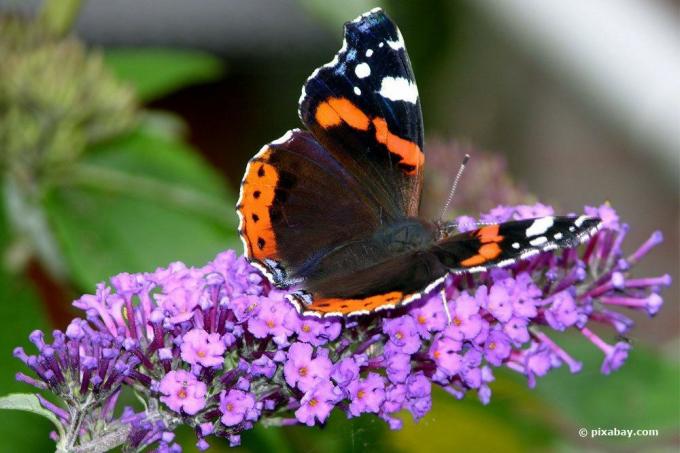
This is a migrant butterfly. It is native to the Mediterranean area and from there it also reaches Germany. He prefers to be in forests, meadows, parks and gardens. The greenish to brown caterpillars have short thorns and feast on Nettles. Every year the admiral brings out two to three generations, the last of which moves south.
Appearance:
- Occurrence: May to October
- Body length: 2 cm
- Wingspan: 6 cm
- Fore wings pale brown in color
- dark brown tip with white and bluish spots
- red transverse band over brown areas of the fore wing
- bluish spots on the posterior wing tip
- brownish, yellowish and bluish marbling underneath
Aurora butterfly (Anthocaris cardamines)
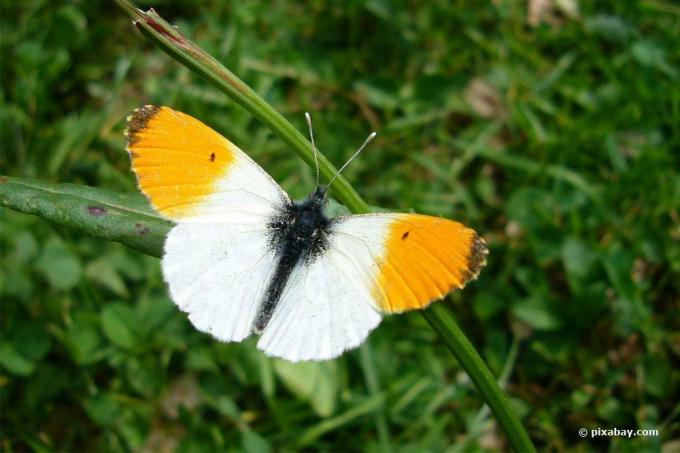
The moth is widespread. It prefers to fly at the edges of forests and damp meadows. The blue-green, slender caterpillars have a white flank. In late autumn these pupate and overwinter.
Appearance:
- Occurrence: March to July
- Body length: 1.5 cm
- Wingspan: 4.5 cm
- Female white wings with black wing tips
- Males white wings with black eye-spot and
- orange coloring of part of the forewing
- Underside of the hind wings marbled greenish brown
C-butterfly (Polygonia c-album)

This butterfly likes to stay at the edges of the forest and in clear areas in mixed and riparian forests. He brings out two to three generations a year. The last one hibernates and is already very active in March. The black caterpillar has reddish stripes, thorns and a white spot on its back. This is very reminiscent of bird droppings, so it can scare off its predators. The caterpillars feed primarily on nettles.
Appearance:
- Occurrence: March to October
- Body length: 2 cm
- Wingspan: 5 cm
- Wing surfaces orange-red
- Slightly yellowish towards the edge
- strongly serrated, dark brown edge of the wing
- numerous red-brownish to black bands and spots on the upper side of the wing
- Underside dark brown, grayish towards the edge
- single orange and white spots
- on the underside of the hind wing bright white "C"
Great Cabbage White butterfly (Pieris brassicae)
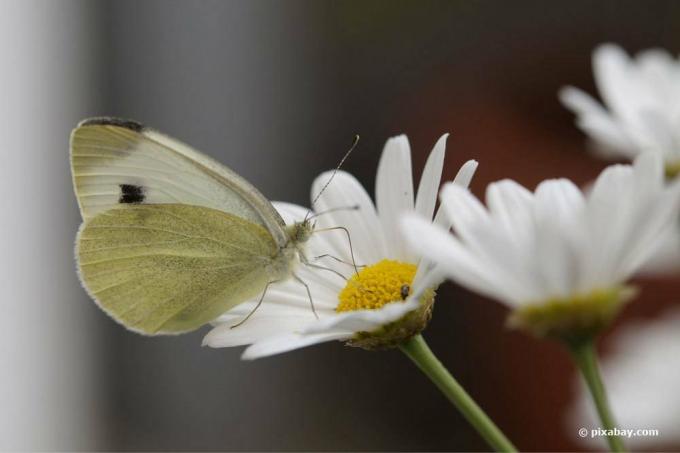
This type of butterfly is common in Germany. As a cultural follower, it can be found from the coast to the mountains, preferring fields, meadows and gardens. Depending on the weather, there are two to three generations. As the name suggests, the caterpillar eats everyone Types of cabbage. Occurring in large numbers, this can lead to major damage from eating. It pupates before winter begins and is very often the victim of parasitic wasps.
Appearance:
- Occurrence: April to October
- Body length: 2 cm
- Wingspan: 6 cm
- white wings
- black tip on the forewings
- Females have two additional black spots on forewings
- Underside of hind wings greyish to greenish
- black spots on wings are absent in males
European common blue (Polyommatus icarus)

These butterflies love open terrain. They can often be found on cultivated land, meadows, gardens and fields. The meadow blue sucks not only on blossoms, but also on damp spots on the ground. The caterpillar is quite inconspicuous, it is greenish in color with short hair and feeds on Clover- and alfalfa species. The caterpillars overwinter and pupate in the following spring.
Appearance:
- Occurrence: May to September
- Body length: 1.5 cm
- Wingspan: 3 cm
- male and female animals colored differently
- The upper surface of the wings of the male is intensely blue to purple
- Edge of the wing white
- Females brownish in color
- Slightly bluish shimmering towards the side of the body
- semicircular, delicate orange dots on wing edges
- The underside of the wings of both is brownish with a greenish inner side
- also semicircular orange spots on the outer edges
Little fox (Vanessa urticae)
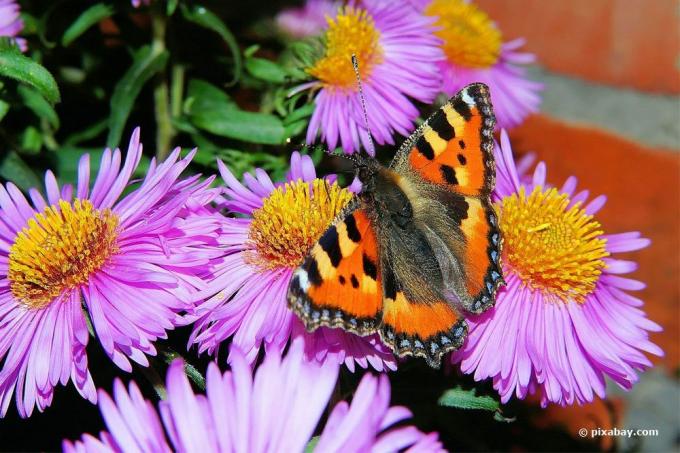
This specimen is most common in this country, from northern Germany to the mountains. The noble butterfly prefers to live near nettles such as clearings, bushes and hedges, meadows, fallow land, but also in parks and gardens. Its diet includes flower nectar. The females lay their eggs on the nettles. Black and yellow caterpillars develop from this. Two to three generations are born each year. The last of them hibernates.
Appearance:
- Occurrence: March to October
- Body length: 2 cm
- Wingspan: 5 cm
- Basic color of the upper side strong orange-red
- Fore wing black and yellowish spots and spots
- Side of the hind wing with brownish hairs
- black colored base
- two bands on the lobed edge of the wing
- inner band consists of black bordered blue dots
- outer band yellowish
- bluish band along the edges of the underside of the wing
- otherwise undersides tinted brown to ocher
- Can be confused with the Great Fox
Chess board (Melanargia galathea)
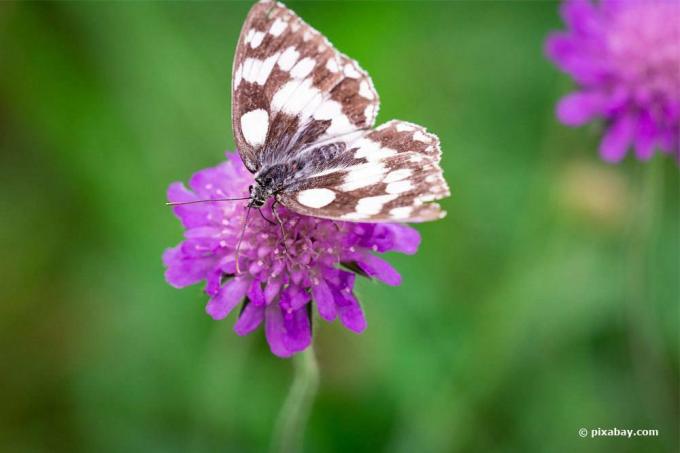
As a habitat, the eye butterfly prefers low mountain ranges, but can also be found on plains. The greenish to brownish caterpillar is hairy with a reddish-brown head. Their diet mainly includes soft grasses. They are mainly found on meadows and rain areas. The caterpillars overwinter.
Appearance:
- Occurrence: May to August
- Body length: 2 cm
- Wingspan: 5.5 cm
- Upper side of the wings white to champagne-colored and marbled with dark spots
- resembles pattern on a chess board
- Underside pattern paler
- on the underside of the hind wing indicated eye-spots
Swallowtail (Papilio machao)
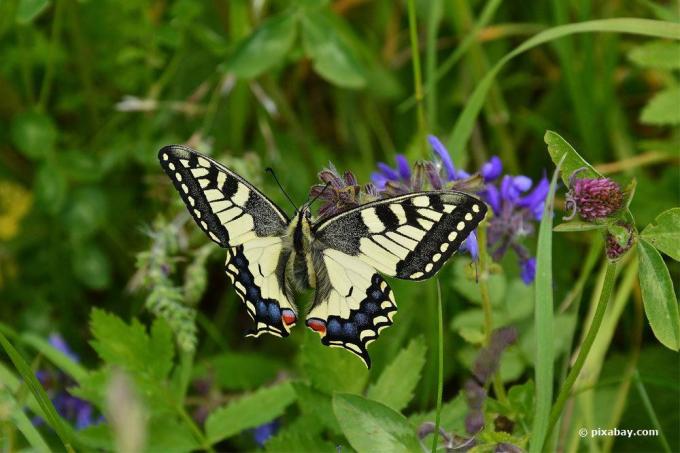
These butterflies are spread all over Germany. They prefer to live near bodies of water, forests and meadows rich in flowers. They are good fliers and cover long distances. Its diet includes flower nectar. The initially black-red caterpillars later turn shiny green with orange-black bands. They are hairless and feed on Umbelliferous plants like parsley, dill, carrots. The caterpillar pupates before wintering. The swallowtail is one of the largest species in Central Europe.
Appearance:
- Occurrence: April to September
- Body length: 2.5 cm
- Wingspan: 8 cm
- Upper side of the wings pale yellow
- Pattern of black spots and lines present
- pale blue banding on the edges of the hind wings
- a red eye-spot on each hind wing
- Similar coloring and patterning on the underside, somewhat paler
- characteristic tips on wing tips
- are reminiscent of the tail skewers of barn swallows
Peacock butterfly (Vanessa io)

The peacock butterfly can often be found in damp mixed forests, alluvial forests, on meadows and on bodies of water, in gardens and parks. These butterflies prefer red to purple flowers and feed on their flower nectar. The female lays her eggs on nettles. As a rule there are two generations a year. The second of these winters in cool buildings and cellars. It dies down quickly in warm rooms, as the energy reserves are quickly used up due to the greater activity.
Appearance:
- Occurrence: March to October
- Body length: 2 cm
- Wingspan: 6 cm
- Upper side of the wing colored red to rust brown
- Hind wings yellowish to orange in color towards the body
- lobed wing edges
- gray to dark brown band along the edges
- A large blue eye-spot on each of the upper sides of the wing
- Eye spot provided with red and yellow markings
- reminiscent of the peacock's tail feathers
- The undersides of the wings are black-brown in color
- occasionally colored sprinkles
Mourning cloak (Aglais antiopa)

The mourning cloak can be found more often in the south of Germany than in the north. It prefers light, mixed forests and meadows and sucks on sap, overripe fruit and fallen fruit, as well as on damp areas of the ground. Adult moths usually live for a year. After hibernating, they lay eggs. In summer, when the new generation appears, their hour has come. The caterpillar is black with numerous thorns and likes to eat willow and birch plants. The conspicuous butterfly can hardly be confused with other butterfly species.
Appearance:
- Occurrence: March to October
- Body length: 2.5 cm
- Wingspan: 7 cm
- Wing surface intense dark brown color
- band framed in black at the edges with blue to purple dots
- typical yellow banding on the outer edge
- Wing edges lobed
- Underside of wing brownish in color
- at the edges turquoise and outer white band
Brimstone Butterfly (Gonepteryx rhamni)

These butterflies are still widespread compared to other butterfly species. They mainly live on the edges of forests, in wetlands, gardens and parks. The butterfly can live to be almost a year old. In late autumn it settles on green plants and hibernates there. Therefore it is also the first butterfly in spring. The green, hairless caterpillars have a white pattern on the flanks. It prefers to feed on buckthorn trees.
Appearance:
- Occurrence: March to October
- Body length: 3 cm
- Wingspan: 6 cm
- Lemon yellow on top and bottom of wings in males
- Orange-red blotch on the upper side of the fore and hind wings
- Underside of this stain gray
- There are pale gray, thin lines on the top and bottom
- Female same drawing
- however, wings pale greenish to whitish



